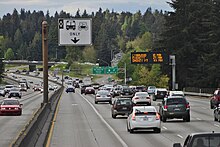
Back ممر المركبات مرتفعة الإشغال Arabic Fahrgemeinschaftsspur German Voie réservée aux véhicules à occupation multiple French Telekocsi-sáv Hungarian Lajur Kendaraan dengan Keterisian Penumpang yang Tinggi ID HOVレーン Japanese 다인승차량전용차로 Korean Carpoolstrook Dutch Pas dla pojazdów z pasażerami Polish Via para veículos com alta ocupação Portuguese
This article has multiple issues. Please help improve it or discuss these issues on the talk page. (Learn how and when to remove these template messages)
|

A high-occupancy vehicle lane (also known as an HOV lane, carpool lane, diamond lane, 2+ lane, and transit lane or T2 or T3 lanes) is a restricted traffic lane reserved for the exclusive use of vehicles with a driver and at least one passenger, including carpools, vanpools, and transit buses. These restrictions may be only imposed during peak travel times or may apply at all times. There are different types of lanes: temporary or permanent lanes with concrete barriers, two-directional or reversible lanes, and exclusive, concurrent, or contraflow lanes working in peak periods.[1]
The normal minimum occupancy level is two or three occupants. Many jurisdictions exempt other vehicles, including motorcycles, charter buses, emergency and law enforcement vehicles, low-emission and other green vehicles, and/or single-occupancy vehicles paying a toll. HOV lanes are normally introduced to increase average vehicle occupancy and persons traveling with the goal of reducing traffic congestion and air pollution.[2][3][4]
- ^ Caves, R. W. (2004). Encyclopedia of the City. Routledge. p. 339.
- ^ "High Occupancy Vehicle Lanes in Canada – Overview". Transport Canada. 2010-08-26. Archived from the original on 2012-04-19.
- ^ Federal Highway Administration (2009-07-27). "A Review of HOV Lane Performance and Policy Options in the United States – Section 1: Introduction". FHWA Tolling and Pricing Program. Retrieved 2012-04-25.
- ^ "Transit Lanes". Roads & Traffic Authority, NSW. Retrieved 2012-04-25. Budapest 29–31 October 2003.
© MMXXIII Rich X Search. We shall prevail. All rights reserved. Rich X Search